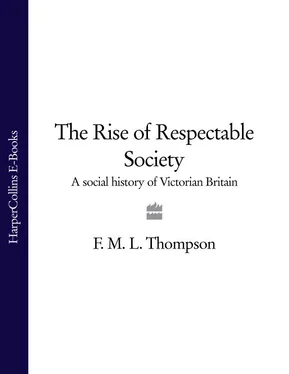1 ...6 7 8 10 11 12 ...25 The socks and stockings produced by the framework knitters were ready to wear, but for the rest the fabrics issuing from the textile industries had to be made up into final products before they could be used by the consumers. Much of this work, with furnishing fabrics as well as in clothesmaking, was done in the home and forms part of that domestic household production which is unmeasured in employment or national income accounting. But a great deal of clothing was made for the market, and the clothing trades (among which boot- and shoemaking are normally classified) were second in importance only to the textile industries themselves. Until 1861 just over one quarter of all the men and women engaged in manufacturing were working in this varied group of trades; thereafter the proportion gradually declined until it was down to one fifth by the end of the century. Total numbers in the group continued to rise, however, from a million in 1861 to 1.2 million in 1901, and by 1911 were on a par with those in the textile industries. No simple generalizations can cover such a diversity of occupations and industries, which ranged from independent village craftsmen-tailors to the sweated labour of seamstresses in city garrets, and from making fashionable gloves to making clogs. An important social feature, indeed, was the ubiquity of country craftsmen in tailoring and shoemaking, and the extent to which local demands were met by local production. There were, however, concentrations of workers producing for more than local markets, the glovemakers of Worcestershire being a case in point. Some of these, like the straw plaiters and straw-hat makers of Bedfordshire and Hertfordshire, constituted an important rural industry, a cottage and village industry of outworkers, mainly women and children, its commercial and finishing organization imparted from the centre at Luton. Others, particularly in clothing proper, came to have a distinctly urban character. The initial effect of mechanization here was to increase the scope for outwork and its commercial organization, for the hand-operated sewing machines which were being introduced from the 1850s onwards were well suited to domestic working and to management by putting-out employers. Clothing factories, in which Leeds led the way from the 1860s, similarly served to increase the numbers of outworkers while pulling more of them into the urban environment; for the very speed and efficiency with which machinery performed some processes in these factories, such as cutting out or buttonholing, generated a massive demand for outworkers for other stages of production which still had to be done by hand, individuals or small workshops specializing in repetitive work on maybe collars, or sleeves, or linings for the large factories.
Clothing factories grew steadily in number and size, and in the quality of their product, in the last two decades of the century, in Manchester and London as well as in Leeds; and they branched out from ready-to-wear men’s clothing into blouses, skirts, and dresses. But at the end of the century even the making of mass-produced clothing, let alone the higher quality and fashion end of the business, was far from having become a pure factory industry. The factory workers needed the cooperation of perhaps hundreds of thousands of outworkers and other manual workers in the small workshops of subcontractors; the distinctive effect of mechanization was to draw more and more of the outworkers into a few large towns, rather than to eliminate or even sharply curtail their occupations. Boot- and shoemaking had a broadly similar history, with different concentrations of large-scale commercial production in Northamptonshire and lesser centres in Somerset and Westmorland. Machines for some parts of the manufacturing process began to be introduced from the mid-1850s, for some of the stitching and cutting-out work. The sequel was a half century of division of labour, albeit not a static division, between what was done by machine and in a factory, and what was done by hand and mainly by outworkers. So late as the early 1890s nearly half the work of bootmaking in Leeds was still done by outworkers in their homes, and the shoemaking villages of Northamptonshire around Kettering, Wellingborough, and Northampton itself were full of outworkers. Complete conquest by machine and factory – outside the high-quality bespoke trade – came late and in a rush in the ten years after 1895, with the adoption of perfected machinery for closing uppers on to soles, and under the spur of competition from imported factory-made American shoes. By this time the image and reality of factory work had come full circle: factory conditions and factory wages were a boon to many of the workers, and boot and shoe operatives pressed for an acceleration of the move into factories as an escape route from penury.
Although textiles and clothing continued to employ more than half the manufacturing population until after 1881, the metalworking and engineering sector had clearly moved into the van of industrial change by mid-century. The Great Exhibition of 1851 was a shrine to machinery of immense variety, ingenuity, and complexity, as well as a festival of manufactured consumer goods; its temple, the Crystal Palace, was itself an engineering product. This symbolized and foreshadowed the fields of innovation and expansion which were to dominate industrialization in the second half of the century. The growth of this sector from one seventh to one quarter of the manufacturing workforce is less important than the diversity of callings and of work situations which sheltered under the broad umbrella of this industrial classification. In economic terms, of technology, capital intensity, or business organization, there was precious little in common between the components of an industrial sector which included traditional crafts and trades like nailmaking, cutlery, or blacksmithing; long-established but totally revolutionized processes like iron- or steelmaking; and completely new occupations like the building of locomotives, and the making of textile machinery, bicycles, or electrical apparatus.
This heterogeneous sector was at the heart of Britain’s position as the workshop of the world, and it was in important respects indeed more of a workshop than a factory. Many traditional occupations of the Sheffield cutlery trades variety, or the manufacture of Birmingham wares, long retained their workshop structure, hundreds of small units perhaps coexisting with a few large establishments in the same general line of business, while small-scale use of power and specialized machinery, displacing former hand tools, could be incorporated into production methods without displacing the skilled workers. In some branches outworkers continued to survive, if not flourish, into the early twentieth century, either because their products could not be made by machines in factories, as with Black Country chainmaking, or because factory-made articles were inferior substitutes, as in nailmaking where the best horseshoe nails remained hand forged even though a factory trade in machine-cut nails and wire nails had been growing since the 1830s. Some categories, like vehicle-making, were no more than convenient labels artificially uniting such disparate trades as coach and carriage building, a handicraft business with a highly articulated hierarchy of specialized skills, and the manufacture of railway carriages and wagons, a new industry which lent itself to large works and assembly methods. Above all, the making of machines generated a whole series of new industrial activities and occupations, multiplying and bifurcating from roots in the work of smiths, millwrights, and toolmakers. It is not too much to say that the development of machine tools, stemming from pioneering work on lathes, planing machines, slotting machines, steam hammers and the like in the 1820s and 1830s, lay at the heart of all subsequent mechanization in manufacturing and growth in the range and variety of consumer goods as well as capital goods. Yet not only was this development of more sophisticated and specialized machinery – turret lathes, milling machines, grinding machines – a long-drawn-out and continuing affair, of American rather more than British origin, but also it had scarcely begun to produce automatic machinery before the beginning of the twentieth century. In effect workers acquired power tools in place of hand tools, files, saws, drills, or hammers, and they had vastly greater speed, capacity, and accuracy. But the operation of these power tools continued to depend on the skill and experience of the operator, while the actual construction of the machine tools themselves continued to rely on the craftsmanship of individual workers and a great deal of skilled handwork in fitting together the components. This situation began to change from the 1890s, but the processes of minute subdivision of labour, production-line working, and deskilling had not reached very far before 1914. Until that time one highly important effect of the advance of mechanization was to generate new and rapidly increasing battalions of skilled workers, highly conscious of their scarcity value. Boilermakers, steam-engine makers, and engineers – makers or operators of machine tools in the main – were craft-minded even if they were not exactly handicraftsmen; they liked to think of themselves as working in engineering shops, not factories, thus conveying the workshop atmosphere of the individual’s control of his tools and his product, even if the scale of operations was likely to be a world away from the traditional workshop.
Читать дальше












